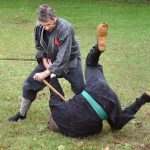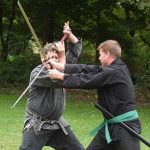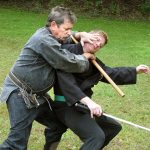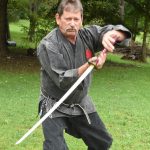MORGANTOWN —Though it’s been debunked, psychologist K. Anders Ericsson once said 10,000 hours of practice leads to mastery.
Tom Stowers, the man who brought ninjutsu to West Virginia in 1989, may agree with Ericsson.
Stowers recently obtained the rank of 10th Dan, the highest formally recognized rank in the art.
“To me, I’ve reached the pinnacle,” he said. “I truly believe that I’m always going to be a student. You never learn it all.”
Ranks in ninjutsu begin at ninth Kyu and progress to first Kyu. A practitioner then earns his/her black belt, or first Dan, before progressing to 10th Dan, the peak of the art.
The 57-year-old said it took every bit of knowledge he’s gained over 32 years of practice to earn the honor of being called Shihan, or master instructor. He was tested last month by Phil Lagare, the highest-ranked American, in Baltimore.
The test was a showcase of the accumulation of all the techniques, knowledge and experience Stowers accumulated — there are no specific requirements for the test, he said.
“Basically, after your fifth degree black belt, it’s all personal between you and your teacher at that point,” Stowers said.
In order to earn that fifth Dan, Stowers had to sense a sword attack from behind, while kneeling, he said.
Stowers’ original senpai, or master, Stephen Hayes, was the first white person to be accepted into the last living school of the ninja in Noda City, Japan. Stowers trained with Hayes for 14 years before Hayes separated from the school.
The art of ninjutsu caught Stowers’ interest in 1985. He read an article about Hayes — who brought the art of ninjutsu to America.
“Our exposure to the ninja back then was a James Bond movie ‘You Only Live Twice.’ That’s the first time Americans ever saw ninjas — the black-cloaked-thousand-way-of-death assassin kind of thing,” he said.
The art and the student Stowers started teaching in 1989 and has trained law enforcement in self-defense techniques, but he won’t train kids.
“It’s a combat art; there is no sport element,” he said.
Most martial arts don’t introduce students to weapons until they’ve been practicing for a while, Stowers said.
But ninjutsu is different. Chris Stout, who’s trained under Stowers for four years, said he began using weapons immediately when he started training.
Stowers said weapons need to be an extension of a ninja’s body and the sooner a young practitioner begins using them, the sooner that can happen.
“Ninjutsu is famous for exotic and hidden weapons,” Stout said.
Ninjas use three kinds of swords, the world-famous katana; the tanto, a small dagger or short sword ranging from about 6 inches
to just under a foot; and the wakizashi, a slightly curved blade between one and two feet long.
Less obvious as a weapon, but no less traditional, is the kusari-fundo — a 2-foot chain with a small weight similar to one used on fishing lines, that can easily be kept on a ninja’s belt.
The variety of weapons aren’t why Stout started training to be a ninja.
The 26-year-old said he always wanted to be able to protect himself and decided he needed to be more physically active.
Stout said there’s no other art like ninjutsu and agreed with his master that it’s a serious martial art and not for show or competition.
In addition to learning how to handle weapons, those learning the ninja way practice two types of strikes — koppo jutsu, or bone breaking strikes, and koshi jutsu, or muscle and nerve ripping strikes, Stowers said.
As a teacher, Stowers said he has to find three ways to explain every move, every technique and every principal because each student learns differently, and what works for one might not for another.
Like any activity, practice is key to success in ninjutsu. Stowers said he practices every day and encourages his students to practice every day.
Reacting without thinking and mirroring an attacker’s intentions are keys to being successful in ninjutsu, Stowers said. Ninjas should be able to do those things using the most natural movement possible, he said.
Stowers said he enjoys teaching and he takes new students to his school, Sukisha Bujinkan. Those interested in learning the ancient art of the ninja can reach Stowers at 304-672-0002.
Tweet Will Dean @WillDean_DP; wdean@domininionpost.com














